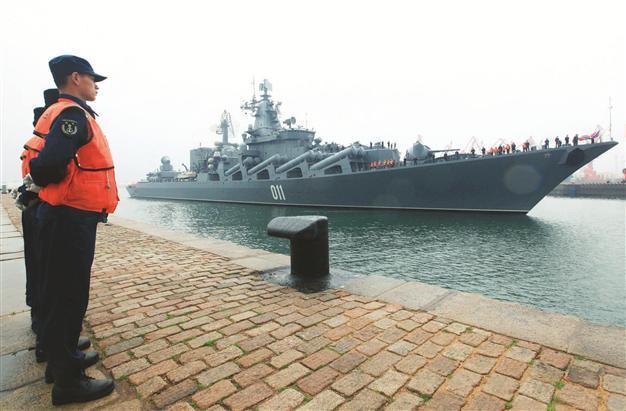Pacific heats up with joint drills

Russian Pacific Fleet’s flagship Varyag, a Slava-class guided missile cruiser, arrives at a naval base in Qingdao in east China’s Shandong Province on April 21. China and Russia launch their first joint naval exercises in the Yellow Sea off China’s east coast.
China and Russia yesterday launched their first joint naval exercises, amid tensions between China and its Asian neighbors over regional territorial claims.The six days of drills are taking place in the Yellow Sea off China’s east coast near Qingdao city, the official China News Service said, adding they were the first dedicated exercises involving the two navies. It also highlighted warming ties between two countries’ militaries and growing cooperation in international affairs. More than 4,000 Chinese service personnel are involved in the exercises, and China is supplying 16 vessels, including five missile destroyers, five missile frigates, four missile boats, a support vessel and a hospital ship. Thirteen aircraft and five shipboard helicopters will also take part, the state-run Xinhua news agency said.
Russia will contribute four warships, three of them missile cruisers, and three supply ships. The exercises come as China is boosting its military spending and asserting its claims over disputed territory, including a chain of islands in the East China Sea also claimed by Japan. China and several Asian countries also have rival claims to uninhabited islands in the South China Sea, which is believed to be rich in oil and natural gas and straddles strategic shipping lanes vital to global trade. The exercises will focus on joint air defense, anti-submarine tactics and search and rescue.
Defense strategy of US toward the Pacific
The move could also be seen as a response to United States’ new defense strategy, announced in January. The Obama administration unveiled a new defense strategy that envisages a shift of focus from Iraq and Afghanistan toward the Pacific, while addressing the increasing threat from China. U.S. Defense Secretary Leon Panetta has called the new strategy a renewed commitment to asserting the U.S. position in the Asia-Pacific region.
“This region is growing in importance to the future of the U.S. economy and our national security,” Panetta said. China and Russia have together participated in four military exercises since 2005, some involving other countries as well. The two countries previously held joint war games in 2005, but these are the first dedicated naval exercises. The exercises could worry China’s Asian neighbors. Beijing and Tokyo have a long-running dispute over a chain of islands, called Diaoyu by China and Senkaku by Japan, which sit in rich fishing grounds that may harbor lucrative energy resources.
In another flare-up which erupted earlier this month, China and the Philippines both dispatched vessels to lay claim to a group of islands in the South China Sea. A senior U.S. commander in the Pacific reaffirmed the United States’ mutual defense treaty with the Philippines yesterday amid increased tensions between the archipelago and China. Commander of the U.S. Marines in the Pacific Lieutenant General Duane Thiessen said the Philippines and U.S. were bound by a military agreement. He also stressed that U.S.-Philippine military exercises that began last week were not directed at China and not linked to territorial tensions. “There is no direct linkage. There is no tie between Scarborough Shoal and U.S. movement in the Pacific,” he said. Chinese and Philippine ships began a standoff in Scarborough Shoal on April 8, giving increased attention to the annual joint military exercise this year. China claims all of the South China Sea, even up to the coasts of other countries including the Philippines, directly conflicting with the claims of many of its neighbors.
Compiled from AFP and AP stories by the Daily News staff.
TAIWAN TO BUY US WARSHIPS
TAIPEI – Agence France-Presse
Taiwan plans to purchase four warships from the United States as part of the island’s efforts to modernize its forces and offset the perceived military threat from China, local media reported yesterday. China claims sovereignty over Taiwan, which has governed itself since 1949, and has vowed to get it back, by force if necessary, even though the island has ruled itself for more than 60 years.
















